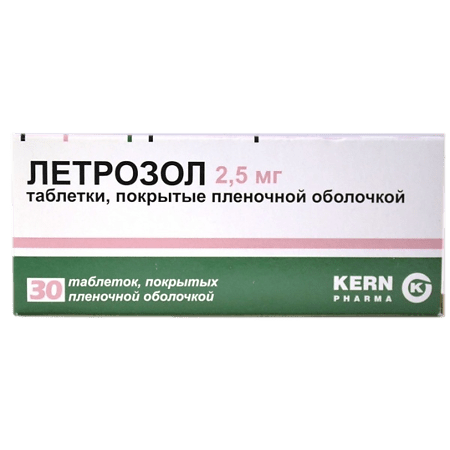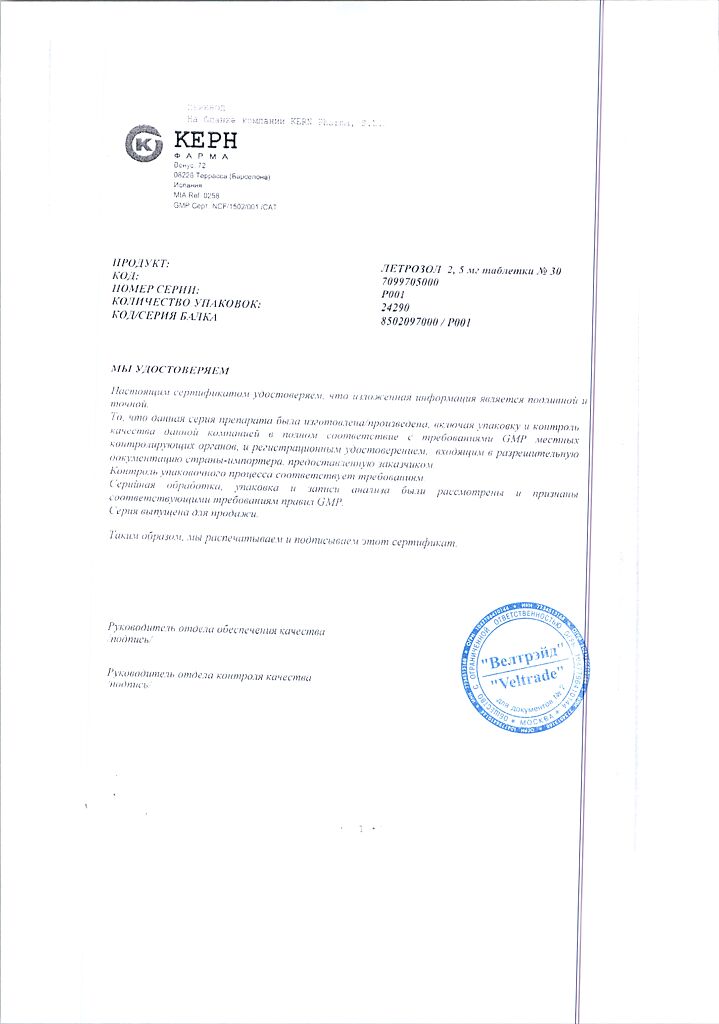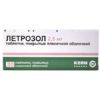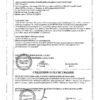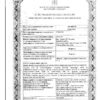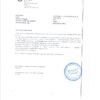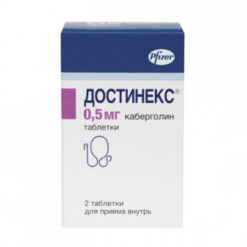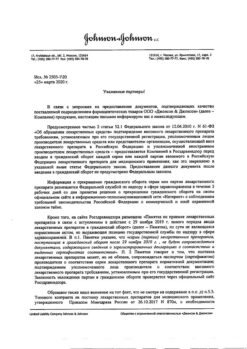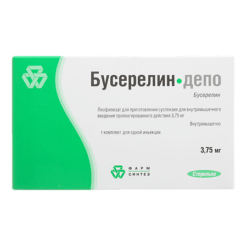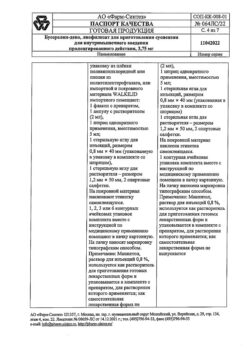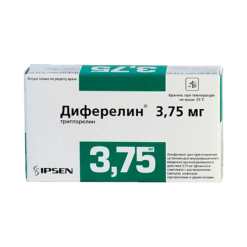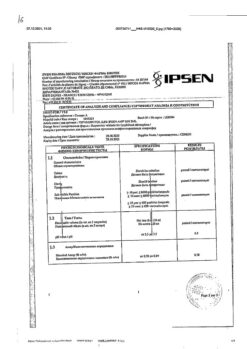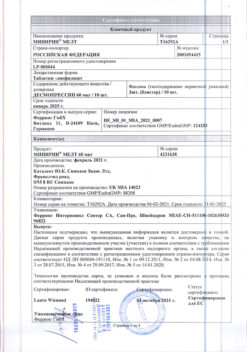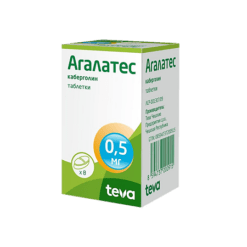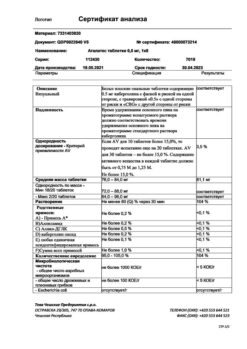No products in the cart.
Letrozole, 2,5mg 30 pcs.
€75.70 €63.09
Description
Pharmacodynamics
Antitumor drug, inhibitor of estrogen synthesis. Letrozole has anti-estrogenic effect, selectively inhibits aromatase (enzyme of estrogen synthesis) by a highly specific competitive binding to a subunit of this enzyme – cytochrome P450 heme. It blocks estrogen synthesis in both peripheral and tumor tissues.
In postmenopausal women, estrogens are formed mainly with the participation of aromatase enzyme, which converts androgens synthesized in adrenal glands (primarily androstenedione and testosterone) into estrone and estradiol.
Daily administration of Letrozole at a daily dose of 0.1-5 mg leads to a decrease in plasma concentrations of estradiol, estrone and estrone sulfate by 75-95% of baseline. Suppression of estrogen synthesis is maintained throughout the treatment period.
When using Letrozole in the dose range from 0.1 to 5 mg there is no disturbance of steroid hormone synthesis in adrenal glands, ACTH test does not reveal disturbance of aldosterone or cortisol synthesis. No additional prescription of glucocorticoids and mineralocorticoids is required.
Blockade of estrogen biosynthesis does not lead to the accumulation of androgens, which are precursors of estrogen.
Letrozole does not cause changes in plasma concentrations of LH and FSH, changes in thyroid function, changes in lipid profile, increased incidence of myocardial infarction and stroke. Against the background of Letrozole treatment the incidence of osteoporosis slightly increased (6.9% compared to 5.5% against placebo). However, the incidence of bone fractures in patients receiving Letrozole does not differ from that in healthy people of the same age.
Adjuvant therapy with Letrozole for early breast cancer reduces the risk of recurrence, increases survival without signs of disease for 5 years, and reduces the risk of secondary tumors.
Letrozole extended adjuvant therapy reduces the risk of recurrence by 42%. A significant benefit in terms of symptom-free survival was observed in the letrozole group regardless of lymph node involvement. Treatment with Letrozole reduces mortality in patients with lymph node involvement by 40%.
Pharmacokinetics
Intake
Letrozole is rapidly and completely absorbed from the gastrointestinal tract after oral administration. Bioavailability on average is 99.9%. Food intake slightly reduces the absorption rate. Mean Tmax is 1 h when letrozole is taken on an empty stomach and 2 h when taken with food; mean Cmax in plasma is 129 ± 20.3 nmol/l when taken on an empty stomach and 98.7 ± 18.6 nmol/l when taken with food, but the degree of letrozole absorption (when assessed by AUC value) does not change.
Significant changes in the absorption rate are considered to be of no clinical significance, so Letrozole can be taken regardless of food intake.
Pharmacokinetics are nonlinear.
Distribution
The binding of letrozole to plasma proteins is approximately 60% (predominantly to albumin, 55%). The concentration of letrozole in erythrocytes is about 80% of that in plasma. The apparent Vd in equilibrium is about 1.87±0.47 l/kg. Css is achieved over 2-6 weeks of daily use at a daily dose of 2.5 mg. No cumulation was noted with long-term use.
Metabolism
Letrozole is largely metabolized with the isoenzymes CYP3A4 and CYP2A6 to form a pharmacologically inactive carbinol compound.
Extracted mainly by the kidneys as metabolites, to a lesser extent – through the intestine. The final T1/2 is 48 hours.
Pharmacokinetics in special clinical cases
The pharmacokinetic parameters of letrozole are independent of patient age.
In renal insufficiency pharmacokinetic parameters do not change.
In moderately severe hepatic impairment (Child-Pugh class B) mean AUC values, although 37% higher, remain within the range of values observed in persons without hepatic impairment. In patients with cirrhosis and severe liver dysfunction (class C according to Child-Pugh scale) AUC is increased by 95%, T1/2 – by 187%. However, given the good tolerability of the drug in high doses (5-10 mg/day), there is no need to change the dose of Letrozole in these cases.
Indications
Indications
Early stages of breast cancer expressing estrogen receptors in postmenopausal women – as adjuvant therapy;
early stages of breast cancer in postmenopausal women after completion of standard adjuvant therapy with tamoxifen – as prolonged adjuvant therapy;
common hormone-dependent forms of breast cancer in postmenopausal women – first-line therapy;
common forms of breast cancer in postmenopausal women (natural or artificially induced) who have received previous antiestrogens therapy.
Pharmacological effect
Pharmacological effect
Pharmacodynamics
Antitumor drug, estrogen synthesis inhibitor. Letrozole has an antiestrogenic effect, selectively inhibits aromatase (an enzyme for the synthesis of estrogen) through highly specific competitive binding to the subunit of this enzyme – the heme of cytochrome P450. Blocks estrogen synthesis in both peripheral and tumor tissues.
In postmenopausal women, estrogens are formed mainly with the participation of the enzyme aromatase, which converts androgens synthesized in the adrenal glands (primarily androstenedione and testosterone) into estrone and estradiol.
Daily intake of Letrozole in a daily dose of 0.1-5 mg leads to a decrease in the concentration of estradiol, estrone and estrone sulfate in the blood plasma by 75-95% of the initial content. Suppression of estrogen synthesis is maintained throughout the entire treatment period.
When Letrozole is used in a dose range from 0.1 to 5 mg, no disturbance in the synthesis of steroid hormones in the adrenal glands is observed, and an ACTH test does not reveal disturbances in the synthesis of aldosterone or cortisol. Additional administration of glucocorticoids and mineralocorticoids is not required.
Blockade of estrogen biosynthesis does not lead to the accumulation of androgens, which are estrogen precursors.
While taking Letrozole, there were no changes in the concentrations of LH and FSH in the blood plasma, changes in thyroid function, changes in the lipid profile, or an increase in the incidence of myocardial infarction and stroke. During treatment with Letrozole, the incidence of osteoporosis increased slightly (6.9% compared to 5.5% with placebo). However, the incidence of bone fractures in patients receiving Letrozole does not differ from that in healthy people of the same age.
Adjuvant therapy with Letrozole for early stages of breast cancer reduces the risk of relapses, increases disease-free survival for 5 years, and reduces the risk of developing secondary tumors.
Extended adjuvant therapy with Letrozole reduces the risk of relapse by 42%. A significant advantage in disease-free survival in the letrozole group was observed regardless of lymph node involvement. Treatment with Letrozole reduces mortality in patients with lymph node involvement by 40%.
Pharmacokinetics
Suction
After oral administration, letrozole is quickly and completely absorbed from the gastrointestinal tract. Bioavailability averages 99.9%. Eating slightly reduces the rate of absorption. The average Tmax value is 1 hour when taking letrozole on an empty stomach and 2 hours when taking it with food; the average Cmax value in blood plasma is 129 ± 20.3 nmol/l when taken on an empty stomach and 98.7 ± 18.6 nmol/l when taken with food, however, the degree of absorption of letrozole (as assessed by AUC value) does not change.
Minor changes in the rate of absorption are considered to be of no clinical significance, so Letrozole can be taken with or without food.
Pharmacokinetics is nonlinear.
Distribution
The binding of letrozole to plasma proteins is approximately 60% (mainly with albumin – 55%). The concentration of letrozole in erythrocytes is about 80% of that in blood plasma. The apparent Vd at equilibrium is about 1.87±0.47 l/kg. Css is achieved within 2-6 weeks of daily use of the drug at a daily dose of 2.5 mg. No accumulation was observed with long-term use.
Metabolism
Letrozole is extensively metabolized by the CYP3A4 and CYP2A6 isoenzymes to form a pharmacologically inactive carbinol compound.
Removal
It is excreted primarily by the kidneys in the form of metabolites, and to a lesser extent through the intestines. The final T1/2 is 48 hours.
Pharmacokinetics in special clinical situations
The pharmacokinetic parameters of letrozole do not depend on the age of the patient.
In renal failure, pharmacokinetic parameters do not change.
With moderately severe liver dysfunction (Child-Pugh class B), the average AUC values, although 37% higher, remain within the range of values observed in individuals without liver dysfunction. In patients with cirrhosis of the liver and severe impairment of its function (class C on the Child-Pugh scale), AUC increases by 95%, T1/2 – by 187%. However, given the good tolerability of the drug in high doses (5-10 mg/day), in these cases there is no need to change the dose of Letrozole.
Special instructions
Special instructions
Patients with severely impaired liver function should be under constant supervision.
During Letrozole therapy, given the possibility of pregnancy, perimenopausal and early postmenopausal women should use reliable methods of contraception until stable postmenopausal hormonal status is established.
Impact on the ability to drive vehicles and other mechanisms that require increased concentration
Some side effects of the drug, such as general weakness and dizziness, may affect the ability to perform potentially hazardous activities that require increased concentration and speed of psychomotor reactions. Therefore, patients should be careful when driving vehicles and operating machinery.
Active ingredient
Active ingredient
Letrozole
Composition
Composition
1 tablet contains:
Active ingredients:
letrozole 2.5 mg.
Excipients:
lactose monohydrate 50 mg,
sodium carboxymethyl starch 2.5 mg,
colloidal silicon dioxide 500 mcg,
microcrystalline cellulose 28 mg,
crospovidone 4 mg,
pregelatinized corn starch 11.5 mg,
magnesium stearate 1 mg.
Film shell composition:
opadry Y 1-7000 (hypromellose, titanium dioxide, macrogol (polyethylene glycol)) 3.73 mg, iron dye yellow oxide 270 mcg.
There are 10 tablets in a blister. There are 3 blisters in a cardboard package.
Pregnancy
Pregnancy
Contraindicated for use during pregnancy and lactation (breastfeeding).
Contraindications
Contraindications
Endocrine status characteristic of the reproductive period;
pregnancy;
lactation period (breastfeeding);
children’s age (efficacy and safety for children have not been established);
hypersensitivity to the components of the drug.
With caution: the drug should be used for lactase deficiency, lactase intolerance, glucose-galactose malabsorption. There is no data on the use of Letrozole in patients with CC < 30 ml/min (before prescribing the drug to such patients, the relationship between the potential risk and the expected effect of treatment should be carefully weighed).
Side Effects
Side Effects
As a rule, adverse reactions were mild or moderate and were mainly associated with suppression of estrogen synthesis.
Determination of the frequency of adverse reactions:
very often (> 10%);
often (1-10%);
sometimes (0.1-1%);
rarely (0.01-0.1%);
very rare (<0.01%), including isolated reports.
From the digestive system: often – nausea, vomiting, dyspepsia, constipation, diarrhea; sometimes – abdominal pain, stomatitis, dry mouth, increased activity of liver enzymes.
From the nervous system: often – headache, dizziness, depression; sometimes – anxiety, nervousness, irritability, drowsiness, insomnia, memory impairment, dysesthesia, paresthesia, hypoesthesia, episodes of cerebrovascular accident.
From the hematopoietic system: sometimes – leukopenia.
From the cardiovascular system: sometimes – palpitations, tachycardia, thrombophlebitis of superficial and deep veins, increased blood pressure, coronary artery disease (angina pectoris, myocardial infarction, heart failure), thromboembolism; rarely – pulmonary embolism, arterial thrombosis, stroke.
From the respiratory system: sometimes – shortness of breath, cough.
Dermatological reactions: often – alopecia, increased sweating, skin rash (including erythematous, maculopapular, vesicular rash, psoriasis-like rash); sometimes – itching, dry skin, urticaria; very rarely – angioedema, anaphylactic reactions.
From the musculoskeletal system: very often – arthralgia; often – myalgia, bone pain, osteoporosis, bone fractures, sometimes – arthritis.
From the senses: sometimes – cataracts, eye irritation, blurred vision, impaired taste.
From the urinary system: sometimes – frequent urination, urinary tract infections.
From the reproductive system: sometimes – vaginal bleeding, vaginal discharge, vaginal dryness, pain in the mammary glands.
Metabolism: often – weight gain, hypercholesterolemia, anorexia, increased appetite; sometimes – weight loss, thirst.
Other: very often – paroxysmal sensations of heat (hot flashes); often – increased fatigue, asthenia, malaise, peripheral edema; sometimes – hyperthermia (pyrexia), dry mucous membranes, generalized edema, pain in tumor foci.
Interaction
Interaction
When Letrozole is used simultaneously with cimetidine and warfarin, no clinically significant interaction is observed.
There is currently no clinical experience with the use of Letrozole in combination with other antitumor agents.
According to the results of in vitro studies, letrozole suppresses the activity of the isoenzymes CYP2A6 and CYP2C19 (the latter moderately). When deciding on the significance of these data for the clinic, it is necessary to take into account that the CYP2A6 isoenzyme does not play a significant role in the metabolism of drugs.
In vitro experimental studies have shown that letrozole at concentrations 100 times higher than plasma Css does not have the ability to significantly inhibit the metabolism of diazepam (a substrate of the CYP2C19 isoenzyme). Thus, a clinically significant interaction due to the effect on the activity of the CYP2C19 isoenzyme is unlikely.
However, caution should be exercised when using Letrozole together with drugs that are metabolized primarily with the participation of these isoenzymes and have a narrow therapeutic index.
Overdose
Overdose
There are isolated reports of cases of Letrozole overdose.
Treatment: symptomatic and supportive therapy is indicated. There are no specific treatments for overdose known. Letrozole is eliminated from plasma by hemodialysis.
Storage conditions
Storage conditions
Store out of reach of children, in a dry, dark place at a temperature not exceeding 25°C.
Shelf life
Shelf life
2 years.
Manufacturer
Manufacturer
Kern Pharma, Spain
Additional information
| Shelf life | 2 years. |
|---|---|
| Conditions of storage | Keep out of the reach of children, dry, protected from light at a temperature not exceeding 25°C. |
| Manufacturer | Kern Pharma, Spain |
| Medication form | pills |
| Brand | Kern Pharma |
Related products
Buy Letrozole, 2,5mg 30 pcs. with delivery to USA, UK, Europe and over 120 other countries.

